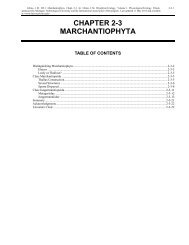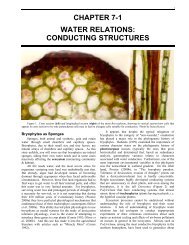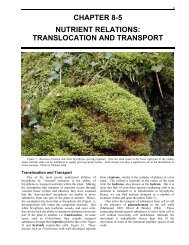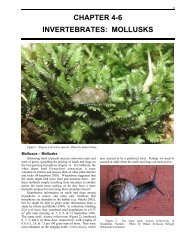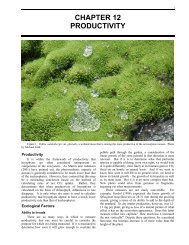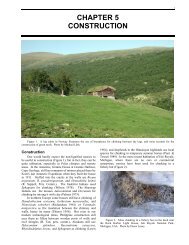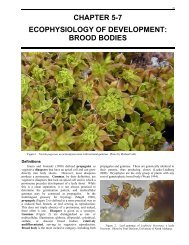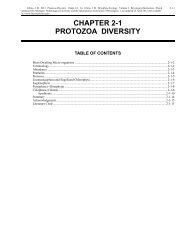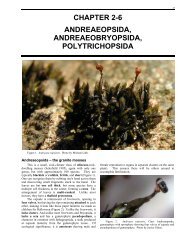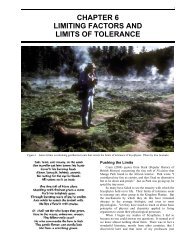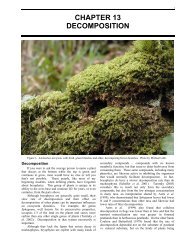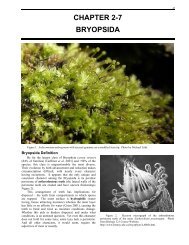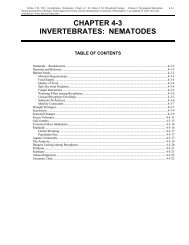Chapter 4-5 Invertebrates Rotifers - Bryophyte Ecology - Michigan ...
Chapter 4-5 Invertebrates Rotifers - Bryophyte Ecology - Michigan ...
Chapter 4-5 Invertebrates Rotifers - Bryophyte Ecology - Michigan ...
Create successful ePaper yourself
Turn your PDF publications into a flip-book with our unique Google optimized e-Paper software.
4-5-6 <strong>Chapter</strong> 4-5: <strong>Invertebrates</strong>: <strong>Rotifers</strong>contributed both habitat and food source for the meiofauna.Both the habitat and the food source were realized throughthe fine particulate matter trapped by the mosses. In thishabitat, Bdelloid rotifers dominated as 76% of theorganisms among 18 meiofaunal taxonomic groups.In moss cushions of Antarctic nunataks, Sohlenius andBoström (2006) found that 82% of their 91 samples hadrotifers, the highest, above the nematodes (64%) andtardigrades (32%). Petz (1997) found that 95% of thesamples from Wilkes Land, East Antarctica, had rotifers,with the highest numbers in mosses (1,311/g), although itwas tardigrades that dominated. Water and organic matterseemed to be the most important controlling factors forthese invertebrate numbers.Before we explore this group of organisms, we need toconsider potential sampling bias and the effects it may haveon the numbers of rotifers in various studies. Because oftheir tendency to attach, rotifers require different samplingtechniques from tardigrades and worms. They do notextract well with the Baermann funnel used so commonlyfor other invertebrates (Merrifield & Ingham 1998).Merrifield and Ingham tested the efficiency of this funneltechnique on the moss Eurhynchium oreganum on theOregon Coast Range, USA, by squeezing and agitating themoss after the funnel extraction and suggested that theirsedentary habit might cause them to be undersampled.AdaptationsLittle has been discussed about adaptations of rotifersto the bryophyte habitat. <strong>Rotifers</strong> among bryophytes canfeed on detrital matter collected by the bryophytes.Kellicottia longispina (Figure 15) is a common planktonspecies that may be well adapted for bryophyte living. Ithas very long spines on its case (lorica) that enable it toattach to the bryophytes (Madaliński 1961).Aquatic bryophytes may provide a refuge duringparticularly heavy stream flow. The number of species inTatra streams increased during spring runoff from 18 inwinter to 24 during runoff (Madaliński 1961). Other factorsthat contribute to substrate choice include temperature,oxygen content, trophic levels, chemistry, food availability,and predators (Pejler & Bērziņš 1989).Two rotifers have found a different way to surviveamong bryophytes. In addition to living in Sphagnumretort cells, Habrotrocha roeperi and Habrotrocha reclusalive inside the outer cells of Sphagnum branches (May1989). May states that these could be considered asparasites. I find this a bit of a puzzle. Variousinvertebrates are known to live in stem cells that havepores, providing an entryway. But how do the rotifers getinto the branch cells?Living in tune with their mossy environment,limnoterrestrial rotifers exhibit a seasonal dynamic thatdepends on water availability and air quality (Kukhta et al.1990; Steiner 1994a, b, 1995a, b). Not only is waterimportant for hydration, but it is necessary for locomotion.The bdelloid rotifers (Figure 2) have a contractile body thatpermits them to creep around on the moss (Sayre &Brunson 1971). And the cilia that form the corona createcurrents as they beat (Figure 16), directing food particlesinto the mouth while thrusting the rotifer forward (Hingley1993). Thus, the corona also contributes to movement.Figure 15. Kellicottia longispina showing its long spinesthat permit it to attach to bryophytes. Photo from Jersabek et al.2003.Pejler & Bērziņš (1989) have somewhat different ideasabout long spines. They claim these are generally found inclear water as a protection against visual predators. This isconsistent with defense against predation shown byBarnhisel (1991) for Bythotrephes, a cladoceran. Rather,Pejler and Bērziņš suggest that adaptations involve thesuitability of the foot, egg-carrying protrusions, and otherlorical structures. Certainly diet plays a role, with somebryophytes being suitable food for detrital feeders.If you are tiny and soft-bodied, you certainly needsome sort of protection or a place to hide. Otherwise, youwill be somebody's dinner. Wilts et al. (2010) discoveredone of the smallest rotifers known, Bryceella perpusilla, anew species, on terrestrial mosses in Germany.Figure 16. Wheels of cilia (corona) on Floscularia sp.(Monogononta). Photo by Martin Mach.Some rotifers are too large to live among bryophytes,in part because the bryophytes cannot house enoughdetritus and bacteria to meet the food needs of the rotifer(Cavanihac 2004; Figure 17).Epp and Lewis (1984) demonstrated that speed ofmotion was related to size in rotifers. Using Brachionusand Asplanchna, they demonstrated that Brachionus haslittle size variation during its development, whereasAsplanchna increases significantly in size as it develops.Nevertheless, both genera decrease their speed ofmovement significantly as their size increases. Brachionususes 62% of its energy for ciliary movement. This is a veryinefficient activity, so one might consider one bryophyteadaptation to be movement instead by crawling. To



